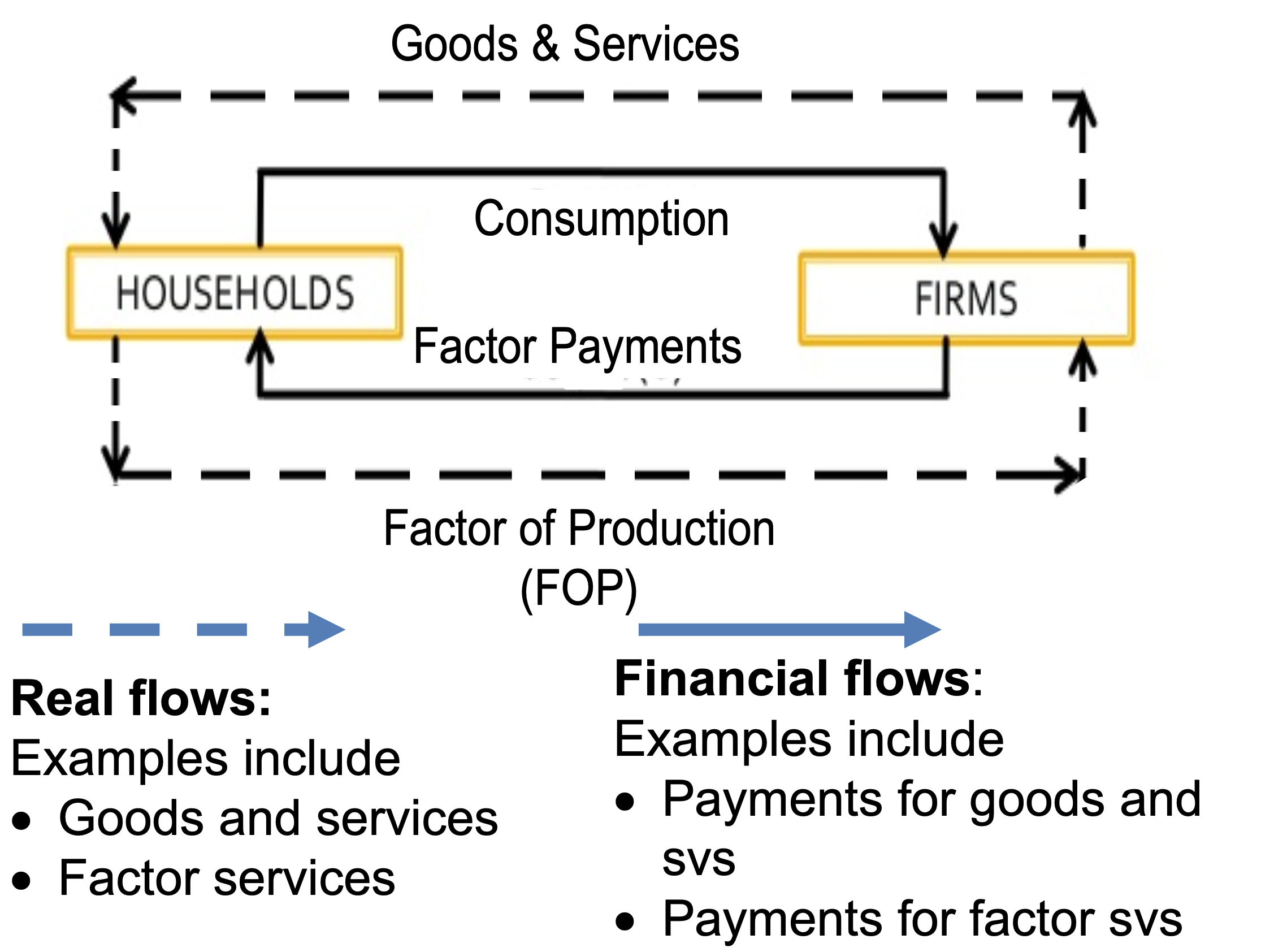Measures of Economic Activity
- There are three ways to measure the value of aggregate output, suggested by the circular flow of income model, all giving rise to the same result:
- Expenditure approach - adds up all spending to buy final goods and services produced within a country over a time period
- Income approach - adds up all income earned by the factors of production that produce all goods and services within a country over a time period
- Output approach - calculates the value of all final goods and services produced in a country over a time period.
National Income
- Measures the monetary value of the flow of output of goods and services produced in an economy over a period of time.
- Main function of National Income Accounting is to provide data to monitor the performance of the overall economy
- National Income of a country can be calculated in 3 ways
- The Output Approach
- Value of all output produced
- The Income Approach
- Sum of all incomes earned
- The Expenditure Approach
- Sum of expenditure incurred
The Production or Output Approach
- Adding up all the money values of all FINAL goods & services produced in the country.
- OR: SUMMING up the VALUE-ADDED by all industries in the economy over a period of time, usually a year
The Income Approach
- Adding up all the EARNINGS of owners of FOPs & resources over a period of time, usually a year
- Returns to FOP
- Rent (Land)
- Wages (Labour)
- Interest (Capital)
- Profits (Enterprise)
- Sum of all the earnings of owners of FOPs & resources over a period of time, usually a year
- National Income = W + R + I + P
The Expenditure Approach
- Sum of the spending by households, firms, government & foreign sector on all final goods & services produced in the country over a period of time, usually a year
- National Expenditure = C + I + G + (X-M)
Back to National Income
- All 3 methods of arriving at the National Income Statistics of a country must yield the same result.
- National Income = National Output = National Expenditure
- The 3 terms can be used interchangeably.
Recap (CFY)
The circular flow of income shows that in any given time period (say a year), the value of output produced in an economy is equal to the total income generated in producing that output, which is equal to the expenditures made to purchase that output.

And back to Aggregate Expenditure
- Aggregate Expenditure (AE) is the total planned spending on final goods and services.
- The elements of aggregate expenditure can be expressed in the equation
- Aggregate Expenditure (AE) is the total planned expenditure on final goods and services at a given price level by economic agents.
- There are 4 main economic agents (Sectors), households (C), firms (I), government (G) and the foreign sector (X-M)
- The aggregate expenditure is the total expenditure in the economy, i.e. the expenditure (spending) of all the ‘players’ in the economy.
- Households
- Firms
- Government
- Foreign sector
Factors affecting AE
Consumption Expenditure “C”
- ‘C’ is the purchase of domestically produced goods and services for the satisfaction of consumer wants.
- That part of national income (NY) that is spent on consumer goods
- Affected by
- Income (Disposable) Y
- Level of interest rates
- Accessibility of credit
- GovernmentPolicy
- Price Expectations
- Savings
Investment Expenditure “I”
- Investments are expenditure on capital goods such as equipment, plants as well as additions to stocks of raw materials and intermediate goods.
- Most factors that affect investment are profit –related--- any change in Revenue and/or Cost
- Interest rates
- Business Expectations
- Government Policy
- Technological Change
- Infrastructure
Government Expenditure “G”
- The amount of spending by the government and is independent of changes in National income in Short Run
- G as a component of AE does not include expenditure on transfer payments
- G1: Current expenditure which provides for day to day functions of government
- G2: Current expenditure to provide for future needs eg schools, roads, power, communications, dams, etc
Net Exports (X-M)
- X is export revenue
- M is import expenditure
- Export revenue (X) refers to revenue received from the sale of goods and services to foreign countries.
- Import expenditure (M) refers to expenditure incurred due to purchases of goods and services from foreign countries.
- Export revenue (X) - An increase in export revenue will cause an increase in output and income.
- X is influenced by the national income of the foreign country and is independent of the national income of the local economy.
- Import expenditure (M) - The national income of the home country is reduced when M increases as there are more financial leakages from the circular flow of income.
- Export revenue (X) involves the sale of goods and services to foreign countries.
- X influenced by changes in the foreign country National Income as well as exchange rates
- Import Expenditure (M) are purchases of goods and services from foreign countries.
- M influenced by changes in the domestic country National Income as well as exchange rates